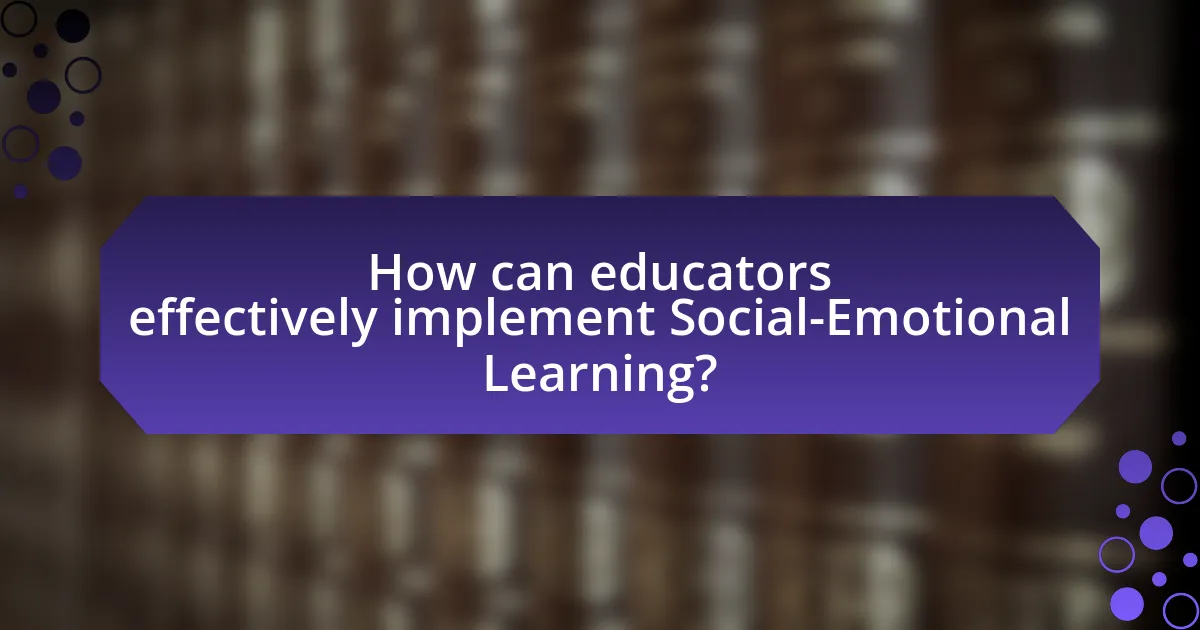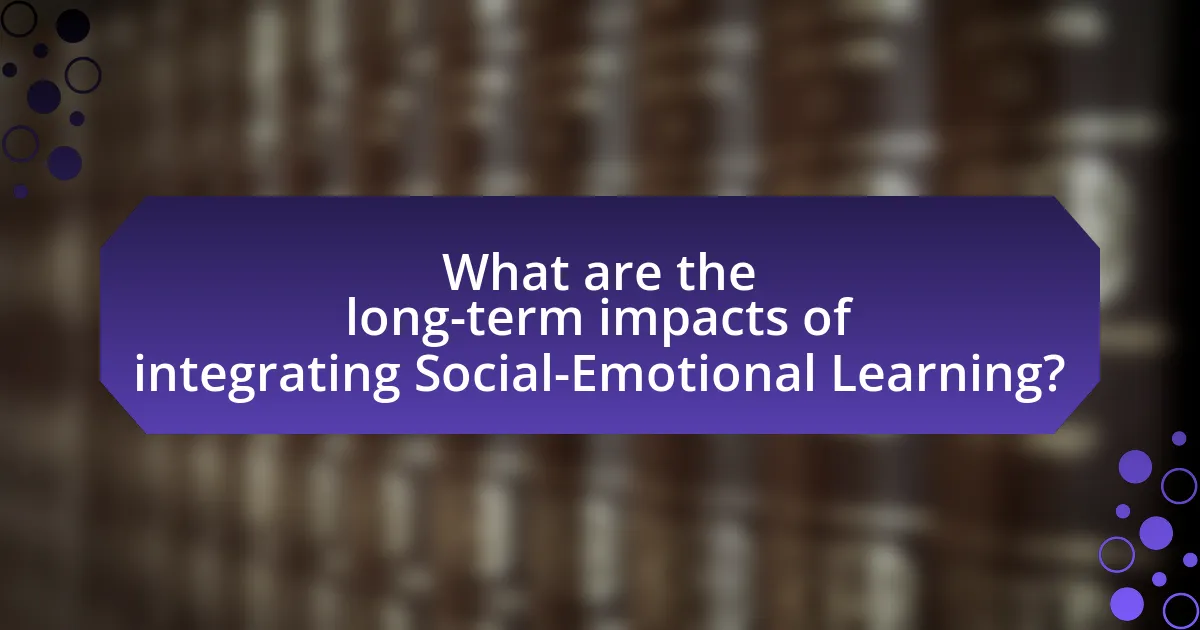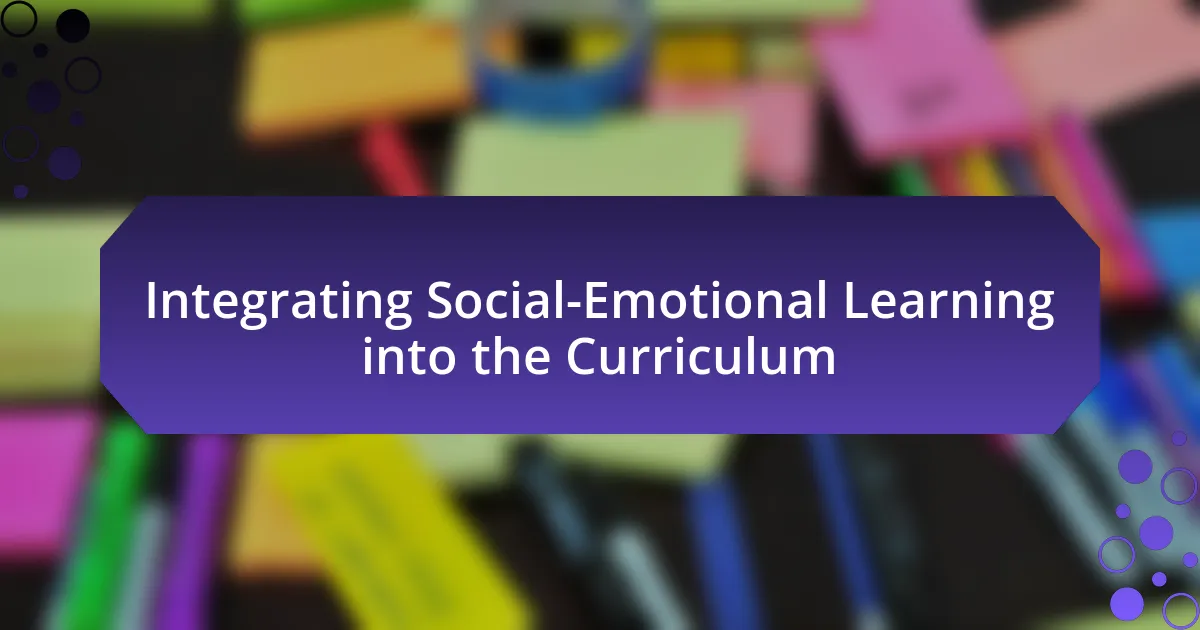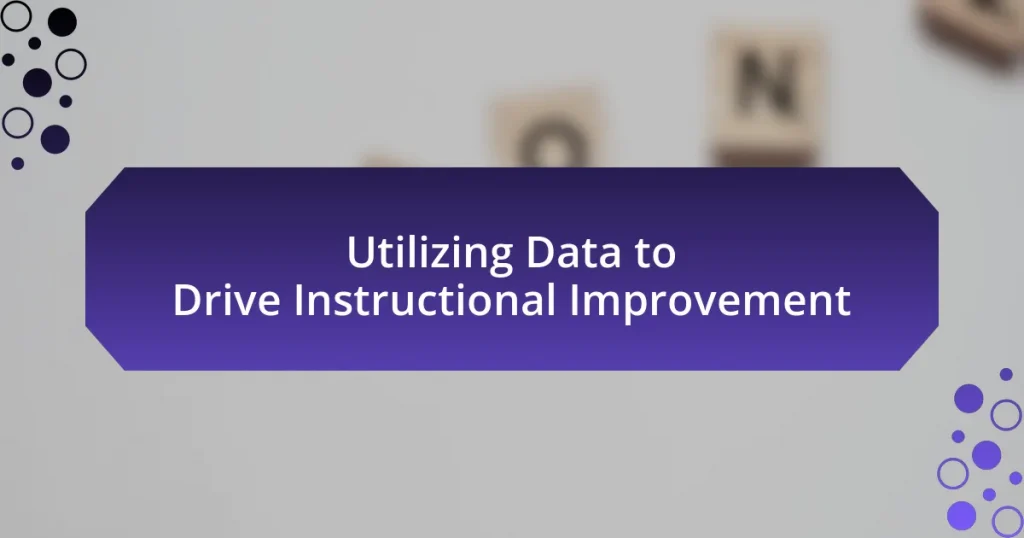Integrating Social-Emotional Learning (SEL) into the curriculum involves embedding practices that enhance emotional intelligence, self-awareness, and interpersonal skills within academic subjects. This approach has been shown to improve student behavior, academic performance, and mental health outcomes, with research indicating an 11 percentile-point gain in academic achievement for students participating in SEL programs. Key components of SEL include self-awareness, self-management, social awareness, relationship skills, and responsible decision-making, all of which interact to foster a holistic educational environment. The article also addresses the challenges of implementing SEL, common misconceptions, and strategies for effective integration, highlighting the long-term benefits for students’ emotional and academic success.

What is Integrating Social-Emotional Learning into the Curriculum?
Integrating Social-Emotional Learning (SEL) into the curriculum involves embedding practices and lessons that promote emotional intelligence, self-awareness, and interpersonal skills within academic subjects. This approach enhances students’ ability to manage emotions, set goals, show empathy, establish positive relationships, and make responsible decisions. Research indicates that schools implementing SEL programs see improvements in student behavior, academic performance, and mental health outcomes, as evidenced by a meta-analysis conducted by Durlak et al. (2011), which found that students participating in SEL programs demonstrated an 11 percentile-point gain in academic achievement compared to their peers.
How does Social-Emotional Learning enhance educational outcomes?
Social-Emotional Learning (SEL) enhances educational outcomes by improving students’ emotional intelligence, which leads to better academic performance and social skills. Research indicates that students who participate in SEL programs demonstrate an 11 percentile-point gain in academic achievement compared to those who do not engage in such programs. Additionally, SEL fosters a positive school climate, reduces behavioral issues, and increases student engagement, all of which contribute to improved educational outcomes. Studies, such as those conducted by the Collaborative for Academic, Social, and Emotional Learning (CASEL), show that effective SEL implementation can lead to long-term benefits, including higher graduation rates and better mental health among students.
What are the key components of Social-Emotional Learning?
The key components of Social-Emotional Learning (SEL) are self-awareness, self-management, social awareness, relationship skills, and responsible decision-making. These components collectively enhance students’ ability to understand and manage their emotions, establish positive relationships, and make informed choices. Research by the Collaborative for Academic, Social, and Emotional Learning (CASEL) emphasizes that integrating these components into educational settings leads to improved academic performance, better behavior, and enhanced emotional well-being among students.
How do these components interact within the curriculum?
The components of social-emotional learning (SEL) interact within the curriculum by fostering a holistic educational approach that integrates emotional intelligence, interpersonal skills, and academic learning. This integration occurs through structured activities that promote self-awareness, relationship-building, and responsible decision-making, which are essential for student development. Research indicates that when SEL is embedded in academic content, students demonstrate improved academic performance, enhanced social skills, and reduced behavioral issues, as evidenced by a meta-analysis conducted by Durlak et al. (2011) in the journal “Child Development.” This study highlights that effective SEL programs lead to significant gains in students’ social-emotional skills and academic achievement, confirming the positive interaction of these components within the curriculum.
Why is it important to integrate Social-Emotional Learning into education?
Integrating Social-Emotional Learning (SEL) into education is crucial because it enhances students’ emotional intelligence, leading to improved academic performance and better interpersonal relationships. Research indicates that SEL programs can increase students’ academic achievement by 11 percentile points, as shown in a meta-analysis by Durlak et al. (2011) published in the journal “Child Development.” Furthermore, SEL fosters resilience, reduces behavioral issues, and promotes a positive school climate, which are essential for holistic student development.
What evidence supports the benefits of Social-Emotional Learning?
Social-Emotional Learning (SEL) has been shown to improve student outcomes significantly. Research indicates that SEL programs can lead to a 23% increase in academic performance, as evidenced by a meta-analysis conducted by Durlak et al. (2011) in the journal “Child Development.” This analysis reviewed 213 studies and found that students participating in SEL programs demonstrated better social skills, improved behavior, and reduced emotional distress. Furthermore, a study by the Collaborative for Academic, Social, and Emotional Learning (CASEL) highlights that schools implementing SEL curricula report enhanced student engagement and a positive school climate, reinforcing the effectiveness of SEL in educational settings.
How does Social-Emotional Learning impact student behavior and academic performance?
Social-Emotional Learning (SEL) positively impacts student behavior and academic performance by enhancing emotional regulation, social skills, and academic engagement. Research indicates that students who participate in SEL programs demonstrate improved behavior, such as reduced aggression and increased cooperation, which fosters a more conducive learning environment. A meta-analysis by Durlak et al. (2011) found that students receiving SEL instruction showed an 11 percentile-point gain in academic achievement compared to their peers. Furthermore, SEL promotes resilience and coping strategies, leading to better stress management and higher motivation, which directly correlates with improved academic outcomes.
What challenges exist in integrating Social-Emotional Learning into the curriculum?
Integrating Social-Emotional Learning (SEL) into the curriculum faces several challenges, including lack of teacher training, insufficient resources, and resistance from stakeholders. Teachers often lack the necessary training to effectively implement SEL strategies, which can hinder its integration into existing curricula. A study by the Collaborative for Academic, Social, and Emotional Learning (CASEL) found that only 25% of teachers feel adequately prepared to teach SEL. Additionally, schools may struggle with limited funding and resources to support SEL programs, making it difficult to provide the necessary materials and training. Resistance from parents and administrators can also pose a challenge, as some may prioritize academic achievement over social-emotional development, leading to a lack of support for SEL initiatives.
What are common misconceptions about Social-Emotional Learning?
Common misconceptions about Social-Emotional Learning (SEL) include the belief that it is solely about teaching students to be nice or that it detracts from academic learning. In reality, SEL encompasses a comprehensive framework that promotes emotional intelligence, relationship skills, and responsible decision-making, which are essential for academic success. Research indicates that integrating SEL into the curriculum can lead to improved academic performance, with a meta-analysis by Durlak et al. (2011) showing that students receiving SEL instruction demonstrated an 11-percentile-point gain in academic achievement compared to their peers. Additionally, some people mistakenly think that SEL is only relevant for younger students; however, it is beneficial across all age groups, enhancing social skills and emotional well-being throughout a person’s life.
How can educators overcome barriers to implementation?
Educators can overcome barriers to implementation by fostering a supportive school culture that prioritizes social-emotional learning (SEL). This involves providing professional development opportunities that equip teachers with the necessary skills and strategies to integrate SEL into their curriculum effectively. Research indicates that schools with strong leadership support and collaborative teacher teams are more successful in implementing SEL programs, as highlighted in the Collaborative for Academic, Social, and Emotional Learning (CASEL) framework. Additionally, engaging parents and the community in the SEL process can enhance buy-in and support, further facilitating successful implementation.

How can educators effectively implement Social-Emotional Learning?
Educators can effectively implement Social-Emotional Learning (SEL) by integrating it into daily classroom activities and curricula. This can be achieved through structured programs that focus on developing skills such as self-awareness, self-management, social awareness, relationship skills, and responsible decision-making. Research indicates that schools implementing SEL programs see improvements in student behavior, academic performance, and emotional well-being. For instance, a meta-analysis by Durlak et al. (2011) found that students participating in SEL programs demonstrated an 11 percentile-point gain in academic achievement compared to those who did not. Additionally, educators can foster a supportive classroom environment by modeling emotional intelligence and creating opportunities for students to practice SEL skills through group work and discussions.
What strategies can be used to incorporate Social-Emotional Learning into lesson plans?
To incorporate Social-Emotional Learning (SEL) into lesson plans, educators can utilize strategies such as integrating collaborative activities, implementing reflective practices, and using literature that promotes emotional understanding. Collaborative activities, like group projects, foster teamwork and communication skills, essential components of SEL. Reflective practices, such as journaling or class discussions about emotions, help students develop self-awareness and empathy. Additionally, selecting literature that addresses social-emotional themes allows students to explore diverse perspectives and understand emotional complexities. Research indicates that these strategies enhance students’ emotional intelligence and academic performance, as evidenced by a study published in the Journal of Educational Psychology, which found that SEL programs can lead to improved social skills and reduced behavioral issues.
How can teachers assess students’ social-emotional skills?
Teachers can assess students’ social-emotional skills through various methods, including observations, self-assessments, and structured assessments. Observations allow teachers to monitor students’ interactions and behaviors in different settings, providing insights into their emotional regulation and social skills. Self-assessments enable students to reflect on their own feelings and behaviors, fostering self-awareness. Structured assessments, such as standardized questionnaires or rubrics, can quantitatively measure specific social-emotional competencies, such as empathy and teamwork. Research indicates that using a combination of these methods yields a more comprehensive understanding of students’ social-emotional development, as highlighted in the Collaborative for Academic, Social, and Emotional Learning (CASEL) framework.
What role do classroom environments play in Social-Emotional Learning?
Classroom environments play a crucial role in Social-Emotional Learning (SEL) by providing a supportive and safe space that fosters emotional growth and interpersonal skills. A positive classroom atmosphere encourages students to express their feelings, build relationships, and develop empathy, which are essential components of SEL. Research indicates that environments characterized by trust, respect, and collaboration significantly enhance students’ emotional well-being and academic performance. For instance, a study published in the Journal of Educational Psychology found that classrooms with strong social support systems lead to improved student engagement and lower levels of anxiety, thereby reinforcing the importance of a nurturing environment in SEL.
What resources are available for educators to support Social-Emotional Learning?
Educators can access a variety of resources to support Social-Emotional Learning (SEL), including curriculum guides, online training programs, and assessment tools. Notable resources include the Collaborative for Academic, Social, and Emotional Learning (CASEL), which provides frameworks and implementation guides for SEL in schools. Additionally, programs like Second Step and PATHS offer structured curricula that focus on developing students’ social-emotional skills. Research indicates that implementing SEL programs can lead to improved academic performance and better emotional regulation among students, as evidenced by a meta-analysis published in the journal “Child Development,” which found that SEL interventions significantly enhance students’ social-emotional skills and academic outcomes.
Which organizations provide training and materials for Social-Emotional Learning?
Organizations that provide training and materials for Social-Emotional Learning include the Collaborative for Academic, Social, and Emotional Learning (CASEL), the Yale Center for Emotional Intelligence, and the Center for Responsive Schools. CASEL is recognized for its framework that guides the implementation of SEL in schools, while the Yale Center focuses on emotional intelligence education and offers various resources. The Center for Responsive Schools provides training programs and curricula designed to enhance social-emotional skills in students. These organizations are well-established in the field and contribute significantly to the development and dissemination of SEL resources.
How can technology be leveraged to enhance Social-Emotional Learning?
Technology can be leveraged to enhance Social-Emotional Learning (SEL) by providing interactive platforms that facilitate emotional awareness and social skills development. For instance, applications and online programs can offer simulations and role-playing scenarios that allow students to practice empathy and conflict resolution in a safe environment. Research from the Collaborative for Academic, Social, and Emotional Learning (CASEL) indicates that technology-based SEL programs can improve students’ emotional regulation and interpersonal skills, leading to better academic outcomes. Additionally, tools like virtual reality can immerse students in experiences that promote understanding of diverse perspectives, further reinforcing SEL principles.

What are the long-term impacts of integrating Social-Emotional Learning?
Integrating Social-Emotional Learning (SEL) has long-term impacts that include improved academic performance, enhanced emotional regulation, and better interpersonal relationships. Research indicates that students who participate in SEL programs demonstrate a 13% increase in academic achievement, as shown in a meta-analysis by Durlak et al. (2011) published in the journal “Child Development.” Additionally, SEL fosters emotional intelligence, leading to reduced behavioral issues and increased resilience, which are critical for lifelong success. Furthermore, individuals with strong social-emotional skills are more likely to maintain positive relationships and exhibit lower levels of anxiety and depression, contributing to overall well-being in adulthood.
How does Social-Emotional Learning influence future success for students?
Social-Emotional Learning (SEL) significantly influences future success for students by enhancing their emotional intelligence, resilience, and interpersonal skills. Research indicates that students who engage in SEL programs demonstrate improved academic performance, better social interactions, and lower levels of emotional distress. For instance, a meta-analysis conducted by Durlak et al. (2011) found that students participating in SEL initiatives showed an 11 percentile-point gain in academic achievement compared to their peers who did not participate. Additionally, SEL fosters essential life skills such as empathy and conflict resolution, which are critical for success in both personal and professional environments. Thus, integrating SEL into the curriculum equips students with the tools necessary for lifelong success.
What skills do students develop through Social-Emotional Learning that are valuable in adulthood?
Students develop critical skills through Social-Emotional Learning (SEL) that are valuable in adulthood, including emotional regulation, empathy, communication, and problem-solving. Emotional regulation enables individuals to manage their emotions effectively, which is essential for maintaining mental health and fostering positive relationships in the workplace. Empathy allows adults to understand and relate to others’ feelings, enhancing teamwork and collaboration. Strong communication skills facilitate clear expression of ideas and constructive feedback, which are vital in professional settings. Problem-solving skills empower individuals to navigate challenges and make informed decisions, contributing to career success. Research indicates that SEL programs lead to improved academic performance and better social interactions, reinforcing the long-term benefits of these skills in adulthood.
How can Social-Emotional Learning contribute to a positive school culture?
Social-Emotional Learning (SEL) contributes to a positive school culture by fostering emotional intelligence, enhancing relationships, and promoting a sense of belonging among students. SEL programs teach students skills such as self-awareness, empathy, and conflict resolution, which lead to improved interactions and reduced behavioral issues. Research indicates that schools implementing SEL see a 13% increase in academic performance and a significant decrease in disciplinary actions, as reported by the Collaborative for Academic, Social, and Emotional Learning (CASEL). This evidence demonstrates that SEL not only enhances individual student well-being but also cultivates a supportive and inclusive environment, ultimately leading to a more positive school culture.
What best practices should educators follow for successful integration?
Educators should prioritize a holistic approach that incorporates social-emotional learning (SEL) into the curriculum through intentional planning and collaboration. This involves integrating SEL objectives with academic content, ensuring that lessons promote emotional intelligence, self-awareness, and interpersonal skills. Research indicates that schools implementing SEL frameworks, such as the Collaborative for Academic, Social, and Emotional Learning (CASEL), report improved student outcomes, including enhanced academic performance and reduced behavioral issues. Additionally, professional development for educators on SEL practices is essential, as it equips them with the necessary skills to foster a supportive learning environment.
How can continuous feedback improve Social-Emotional Learning initiatives?
Continuous feedback enhances Social-Emotional Learning (SEL) initiatives by providing real-time insights into student emotional and social development. This ongoing communication allows educators to identify areas where students may struggle, enabling timely interventions that support emotional growth and relationship-building. Research indicates that schools implementing continuous feedback mechanisms report improved student engagement and emotional well-being, as feedback fosters a supportive learning environment. For instance, a study by Durlak et al. (2011) found that SEL programs with regular feedback loops significantly increased students’ social skills and reduced behavioral problems. Thus, continuous feedback is essential for refining SEL initiatives and ensuring they meet the evolving needs of students.
What role do parents and the community play in supporting Social-Emotional Learning?
Parents and the community play a crucial role in supporting Social-Emotional Learning (SEL) by providing a nurturing environment that reinforces the skills taught in educational settings. Parents can model emotional intelligence and effective communication, which helps children develop empathy and self-regulation. Community organizations can offer resources and programs that promote SEL, such as workshops and support groups, thereby extending learning beyond the classroom. Research indicates that when parents are actively involved in their children’s education, including SEL initiatives, students demonstrate improved emotional well-being and academic performance. For instance, a study by the Collaborative for Academic, Social, and Emotional Learning (CASEL) found that comprehensive SEL programs involving families lead to better outcomes in student behavior and academic success.



